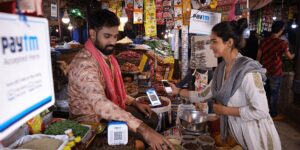Content is everywhere these days, but monetising it remains one of the most formidable challenges for media platforms.
But Gurugram-based Made in India audio app Khabri has taken up the challenge head-on.
It has ambitious plans to get more paid subscribers by offering content that provides real-world value to help students crack various competitive exams.
Khabri provides content in four segments – news, knowledge, government jobs, and inspiration. But the core offering now is to help users prepare for various competitive exams of government jobs in Indian languages, especially in Hindi.
“We are converting non-learning time into learning time,” says Sandeep Singh, Co-founder of Khabri.
He explains there is enough passive consumption time like travelling during which a user can use the audio app for learning. “Audio solutions help you memorise, revise, and listen to lectures.”
Launched in October 2017, Khabri was founded by Sandeep Singh, Pulkit Sharma, and Aankit Roy. The a-ha moment was when the three founders realised the lack of a legal permit for news broadcasters in India to air content on private radio channels.
The app, designed to cover local as well as national and international content, aggregates audio content across categories like news, current affairs, knowledge, government jobs, devotions, books, movies, Bollywood, and motivation.
All about content
The advent of the COVID-19 pandemic with work from home and the closure of educational institutions created a new dynamic for audio apps like Khabri, which saw more users coming onto the platform. Alongside, there was a steady rise in the number of content creators on the platform.
Khabri has three categories of content providers on its platform: organised teaching institutes that help students prepare for competitive exams, individual teachers who have created a brand of their own within their circles, and aspiring creators who put out their own set of good content.
In 2020 alone, Khabri added about 7,000 content creators.
Sandeep says the idea was to “create products where consumers will pay”. For this, it also worked on a system to track the user rating of content creators.
The monetisation push
Khabri realised that it could not just rely on advertisements as a revenue stream and had to look at other options. All this boiled down to quality content for users inclined to pay.
The audio platform pushed out this initiative in July 2021 and sold about 700-odd courses. This included bundling its audio content along with offline training institutes. Apart from content for competitive exam prep, it also focused on aspects like financial education and English learning and “anything which brings competence in terms of knowledge”.
Sandeep says around 1.4 percent of its user base had become paying subscribers since the launch in July last year, which he says was done with “zero noise”, i.e. lack of marketing.
At present, Khabri has registered five million downloads with close to 0.5 million monthly active users (MAUs), a number that is growing at 20 percent.
In terms of engagement, Khabri noticed paid users were spending 44 minutes per session as they offer were long-form audio content. The target audience was the 18-35 years age group, and 80 percent of their users belong to the 18-24 years age group.
Khabri has a 70:30 revenue-sharing model with content creators, with the startup retaining 30 percent as a subscription fee.
Strategising to grow
The monetisation strategy was launched in July 2021, and the initial three to four months were spent on getting more content creators and focusing on the discoverability of information.
Sandeep says the audio content startup did about 19,000 paid transactions in December 2021 – this figure jumped to 36,000 in January 2022.
Khabri focused on a few nuances to create stickiness, For example, it followed a decentralised model with heterogeneity in terms of the content creators.
Citing an example, Sandeep says that the approach by a person in Chennai while teaching history will be very different from somebody in Patna. This ensures that Khabri was able to address the requirements of different sections of its audience.
The startup remains steadfast in its focus on Indian languages and the Bharat market. It has started with Hindi and plans to offer content in five other Indian languages.
“We want to reach out to people keen to use these learning tools to better their lives,” Sandeep says.
Khabiri is also looking at other monetisation channels in addition to subscriptions. These will include the tipping route where users can provide the tips after a live session, which is akin to “guru dakshina”. Fee-based quizzes are also planned.
Given the traction that Khabri has witnessed over the last couple of months, it has aggressive targets ahead. It is looking at achieving 6.8 million MAUs by end of March 2023 with conversion to subscribers being around 4-6 per cent of its user base.
“We want the supply side to be really strong with more choices, and this will help us in higher conversion rate,” Sandeep says.
Into the future
Khabri is also looking at whether it can replicate its playbook in other countries with large non-English speaking populations such as Indonesia.
Sandeep says the audio content startup will focus on learning and providing the value of upskilling to its user base.
Khabri faces no direct competition from other audio platforms in the learning category, but it has indirect competition with other digital education platforms like edtech startups.
It has been an eventful journey for Khabri, which has found backing from Silicon Valley seed accelerator Y Combinator, GSF Accelerator’s Rajesh Sawhney, Titan Capital’s Kunal Bahl and Rohit Bansal, ex-Twitter VP Shailesh Rao, and other angel investors.
Over the years, it has had its own share of learning, bringing down the number of categories it focused on from 22 to just four.
“We learnt to keep our business very simple and created a learning platform which would provide crisp information,” Sandeep says.










